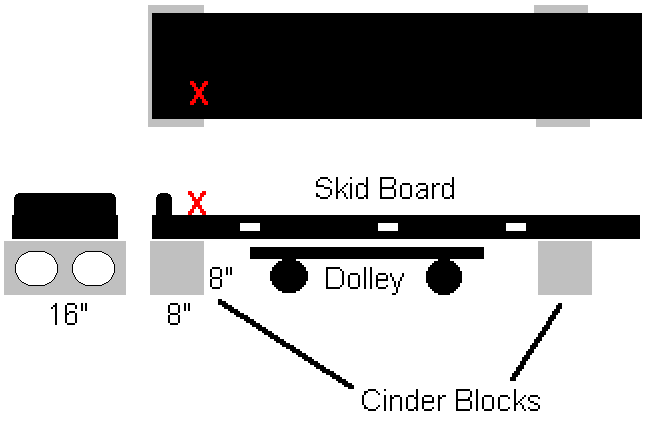| You Are Not Logged In | Login/Get New Account |
|
Please Log In. Accounts are free!
Logged In users are granted additional features including a more current version of the Archives and a simplified process for submitting articles. |
|
MMD
 Gallery
Gallery
 Pictures
Pictures
 tuttle_Moving
tuttle_Moving
|
|
by John A. Tuttle (011003 MMDigest)
'X' marks the spot ! Charles Kelly's posting (011002 MMDigest) really strikes a nerve because I have to travel from New Jersey to Ohio in early November to repair the damage caused by the three grown men who recently moved a customer's Steck Duo-Art Reproducing Grand. They were supposedly "Piano Specialists". They rested the piano on the stack before tipping the piano onto the skid board, which damaged the stack. Before I go any further, please understand that my 135 pound wife and I (all of 156 pounds) moved the instrument to Ohio by ourselves, but we had the correct equipment to do the job. The correct equipment includes two cinder blocks, a manual floor jack (or correctly sized 4x4-inch board), a skid board, three stair rollers, a 7-foot ramp, a dolly, and lots of movers straps and blankets. You should also have a socket wrench set, an assortment of screw drivers, and a leather mallet or rubber hammer (for legs and lyres that are 'wedged'). Next, the lyre and left leg should always be removed from every grand piano before the piano is tipped. The lyre was never designed to support the weight of the instrument. Period!! Armed with the above tools and equipment: Step One: remove the left leg and support the weight of the piano with the jack (or the 4x4) such that the piano is about 6" higher on the left side than when it's resting on its leg. This provides enough clearance to easily remove the lyre even if you're moving a grand with the Ampico mechanism, which has the pneumatics in the box that's attached to the top of the lyre. (The lyre on most regular grands comes off easily before the left leg is removed. So there is no need to elevate the piano any higher than the leg.) Step Two: remove the lyre, insuring that the screws or bolts used to secure it in place do not get mixed up. In some cases, the screws or bolts are different lengths. Mixing them up can be a recipe for problems when putting the unit back together. Step Three: Place the skid board on the cinder blocks (see picture). Place one block at the front of the board and the other approximately four feet from the front. This provides adequate room to put the dolly under the board. (Elevating the board 8" off the ground provides adequate clearance for the stack, which hangs down from the underside of the instrument approximately 6"-7". Adding to that the height of the skid board (about 2"), this gives you at least 2"-3" of free air space between the stack and the floor when the instrument is tipped down onto the board.) Also, if you're moving a unit that has the 'aprons' around the stack, they should be removed before the leg and lyre are taken off. Here again, make sure all of the screws are kept in their correct orientation. Step Four: Tip the instrument onto the board such it contacts the board approximately 2-3 inches from the front of the board (near the lip) and 2 to 3 inches 'in' from the right hand edge of the board (see picture: the red 'X' marks the spot). Step Five: Continue tipping the instrument over until it is standing upright on the skid board. Once you have a little experience, you'll find that the board has to be placed at an angle to the piano such that when it's tipped all the way onto the board it will be squarely on the board. You'll also discover that it actually requires much less effort (work) to tip the unit because gravity isn't working against you quite as hard as it does when the piano has to be let down to the floor. Step Six: Blanket the piano and strap it to the skid board. Make absolutely certain that the straps _do not_ contact the stack or any of the other parts of the player mechanism. Period!! Step Seven: With the piano dolly in the correct position under the skid
board (and between the two cinder blocks), lift the back end of the skid
board and remove the rear cinder block. Then lift the front end and
remove the front block.
That's it! When setting the instrument back up, reverse the above procedure. Although it is a bit precarious, the above steps can actually be done by one person. I know because I've done the job all by myself in the shop. The two tricks are a stable floor jack (manually operated) and the two cinder blocks. John A. Tuttle (Smart -- Not Strong!)
03 October 2001 |
|
|
|
|
|
|
|
|
|
CONTACT FORM: Click HERE to write to the editor, or to post a message about Mechanical Musical Instruments to the MMD Unless otherwise noted, all opinions are those of the individual authors and may not represent those of the editors. Compilation copyright 1995-2026 by Jody Kravitz. Please read our Republication Policy before copying information from or creating links to this web site. Click HERE to contact the webmaster regarding problems with the website. |
|
|
||||||
|
